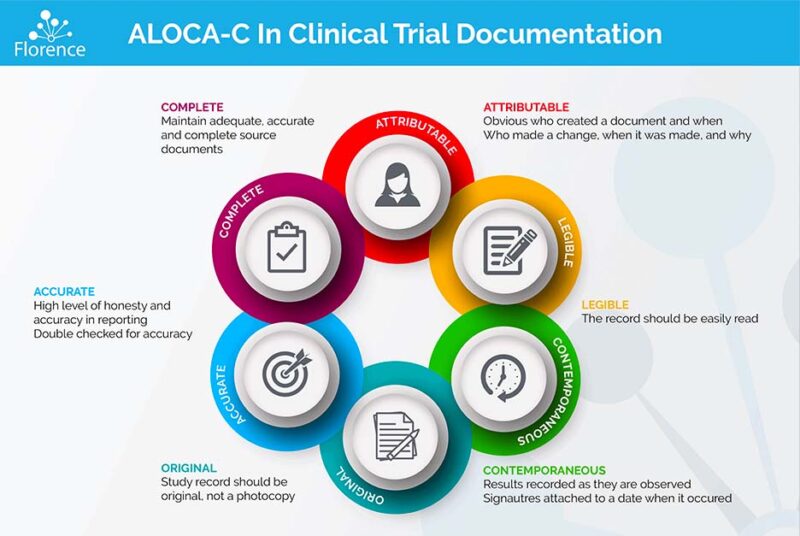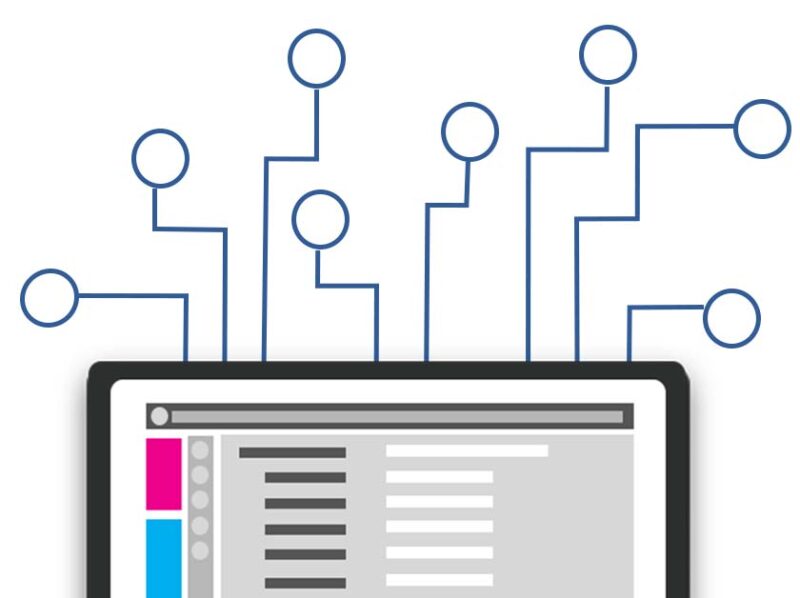What is eSource?
By Andrea Bastek, Ph.D., Senior Director of Innovation at Florence
With contributions from Beau Bruneau, Innovation Business Analyst at Florence
Ask 5 clinical trial professionals what eSource is, and you’ll get 5 different answers. One person may tell you about capturing source data on a fillable PDF, while another talks about using wearable devices and another brings up Electronic Health Records (EHR). So what is eSource?
All of those answers are right. eSource doesn’t refer to one application or program. Instead, it refers to electronic source data from a variety of software systems.
If your clinical trial organization is thinking about embracing eSource, you first need to understand what eSource means and which types of software can help with it.
In this article, we’ll cover:
- Defining eSource
- The benefits of eSource
- What is eSource today?
- How to use eSource with Florence eBinders
Keep reading to learn more about the value, benefits, and process of implementing an eISF (electronic Investigator Site File) and eSource solution.
Defining eSource
The FDA defines source data as “all information in original records and certified copies of original records of clinical findings, observations, or other activities in a clinical investigation used for reconstructing and evaluating the investigation.”
Historically, this meant a staggering amount of papers: worksheets, data collection notes, questionnaires, printouts from the electronic medical record (EMR), and other paper records, just to name a few.
To cut down on the time spent gathering, uploading, scanning, and printing papers, the FDA encourages the use of electronic source data, or eSource, which is simply any “data initially recorded in electronic format.”
So what is eSource? “eSource” is a broad category, rather than a single system or product. In fact, a wide range of systems can generate or capture eSource. A few of them are:
- Digital medical devices (like imaging or laboratory machines)
- Electronic diaries
- Sensors or wearables
Data initially recorded in the electronic health record (EHR), as well as any other data collected electronically according to the clinical trial protocol, also falls into the eSource category.
Whether source data is collected on paper or electronically, ICH Good Clinical Practice guidelines require that it meet ALCOA-C standards. This means that source data must be:
- Attributable
- Legible
- Contemporaneous
- Original
- Accurate
- Complete
If you’d like to learn more about how to follow these guidelines, you can check out our guide to ALCOA-C.

The benefits of eSource
The FDA actively supports eSource. In their guidance on electronic source data, they say that “in an effort to streamline and modernize clinical investigations this guidance promotes capturing source data in electronic form.”
“Streamline and modernize” are keywords. The FDA advocates for eSource because it can help clinical trials run faster than paper source data can.
By adopting systems that allow increased electronic data capture, sites and sponsors can leverage the benefits of eSource. These include resource optimization and remote monitoring.
Resource optimization
Transferring paper processes to electronic systems can help sites make better use of resources. Rather than filling storage rooms with binders, folders, and forms that staff have to be on-site to access, sites can store all of their relevant documents in one secure, online location that they can reach anywhere they have a computer.
With paper, site staff also have to spend time searching for documents every time they need to be reviewed or updated, and they must walk or drive to investigators when they need wet-ink signatures.
With eSource, staff can mark a form that needs to be signed and send the request straight to the investigator, who can sign from their phone or computer.
Finding opportunities to use eSource instead of paper source can result in enormous time and resource savings for sites:
- Eliminate the storage space needed for paper documents and binders
- Reduce the time spent carrying paper documents to investigators or other staff
- Capture source data during a patient’s visit instead of forcing staff to scan and upload documents afterward
To learn more about the benefits of eSource, check out our eBinders product tour, which discusses many eSource features.
Remote monitoring
Using eSource facilitates remote monitoring, which makes it easier for clinical research sponsors and CROS to work with sites around the world. Although the U.S. remains the country with the largest number of clinical trials, China, Japan, Germany, and the U.K. all host tens of thousands of trials every year.
Performing clinical trials internationally can give sponsors access to diverse populations and speed up recruitment timelines by 42%. Pfizer used this technique during the COVID-19 pandemic when they tested their vaccine across 6 countries and 5 continents.
But sponsors who want to run international trials can’t rely on paper binders. Asking monitors to travel or faxing documents every time source data needs to be reviewed, especially across time zones, slows down clinical trials dramatically.
Investing in remote monitoring capabilities reduces this issue. Monitors can review sites’ documents and source data frequently and from a distance. And remote monitoring is most efficient when it includes access to electronic source data.
eSource helps sites and sponsors by:
- Facilitating remote monitoring
- Promoting real-time data review
- Increasing data accuracy and completeness

What is eSource today?
The FDA’s eSource guidance document, written in 2013, discusses 5 potential methods of source data capture:
- Direct Entry of Data into the eCRF
- Automatic Transmission of Data From Devices or Instruments Directly to the eCRF
- Transcription of Data From Paper or Electronic Sources to the eCRF
- Direct Transmission of Data From the Electronic Health Record to the eCRF
- Transmission of Data From Patient-Reported Outcome (PRO) Instruments to the eCRF
The electronic Case Report Form (eCRF) is defined as “an auditable electronic record of information that generally is reported to the sponsor on each trial subject, according to a clinical investigation protocol.”
Today, an eCRF is generally thought of as a form in EDC software where site staff manually enter data.
What is eSource: common forms of eSource
The third method on the FDA’s list, “Transcription of Data From Paper or Electronic Sources to the eCRF,” makes up the majority of eSource as of 2022.
Clinical research site staff collect information using paper and electronic tools and then transfer that data to a platform where their sponsors can review it, like Florence eBinders. 60% of sites indicate they are currently using a software platform that lets them import and store electronic source data.
That means 40% of sites say they aren’t using any eSource at all. Why?
Sometimes, sites don’t realize they’re using eSource because they don’t know what the relatively new term means. Other sites don’t use eSource because they’re afraid of compliance errors that could lead to inspection findings.
That’s why it’s so important for any site using an eSource platform to ensure that platform is compliant with national regulations from agencies like the FDA, MHRA, and EMA, as well as with privacy regulations like HIPAA and GDPR.
If you’d like to learn more about how electronic platforms can follow clinical trial regulations, check out our compliance resources.
What is eSource: rare forms of eSource
The other forms of eSource the FDA outlines are rare. Here are a few eSource types we don’t see very often yet:
- Direct entry of data into the eCRF
- Automatic transmission of data from devices or instruments
- Direct transmission of data from the EHR
- Automatic transmission of data from ePRO software
These possibilities are exciting, but they need time to mature. The technology isn’t yet widely available or consistently compliant.
When sites do use sensors, wearables, or ePRO software, data often goes directly to the sponsor, which can lead to concerns about data ownership and oversight. For these forms of software, clinical trial sites, CROs, and sponsors need to prioritize data privacy and compliance when choosing their vendor.
For now, choosing a compliant platform that can capture and hold electronic source data, like an electronic participant binder, appears to be the most popular form of eSource for sites.
If you’d like to learn more about forms of storage for eSource, check out our eBinders product tour.

How to use eSource with Florence eBinders
No single piece of clinical trial software can perform every eSource function. But Florence eBinders provides several easy-to-use features that can help research sites reduce paper workflows and store electronic source data.
Florence also offers a Monitor Review Module to facilitate sponsors’ and CROs’ access to sites’ source data.
Florence eSource features
So what is eSource from Florence’s perspective? Here are a few of the eSource features Florence currently offers:
- Fillable forms to easily capture source data in real-time
- The ability to create compliant certified copies of source data
- eLogs to keep your logs updated and easily accessible
- Our Electronic Health/Medical Record integration, ePrinter
- Monitor Review Module to facilitate sponsors’ access to eSource
How do these features help?
Florence’s features help sites import and store source data that has first been collected on paper or a different software platform (not the EDC).
It’s useful and efficient to collect all of these various data sources into a central online location like eBinders. Why? Having all of your data in one place lets clinical research staff see the full picture of how a participant is doing without having to dig through multiple software systems, paper binders, or files.
This central location can also facilitate remote monitoring. Monitors can log into Florence and see all of the documents and data the site has given them permission to see, without needing to travel to the site.
Fillable forms
Any document can be made into a fillable form in Adobe, uploaded in eBinders, and completed there in real-time. Sites can transform worksheets, clinical outcome questionnaires, source forms, and paper CRFs into fillable forms. These forms can then be easily duplicated and distributed for each participant and completed by research staff in real-time.
Florence’s tasks and signature requests make it easy to get these forms approved and signed by Principal Investigators (PIs) or other site staff.
Certified copies and transferring documents to eBinders
Studies can be complicated, and paper often can’t be eliminated completely. In those cases, sites can scan source documents and store them in eBinders using simple drag-and-drop, document upload, or email-to-folder features.
Clinical research sites must retain original source data. But they don’t have to keep the actual paper! The FDA states that certified copies of the original source are acceptable, and Florence also offers the ability to quickly create certified copies.
Certified copies require a Part 11-compliant electronic signature and come with a dated timestamp and user information. Only users with permissions can create them, and like all other documents in eBinders, certified copies have an automated audit trail.
EHR/EMR integration with ePrinter
Finally, Florence’s ePrinter lets users import files from their Windows computer directly into eBinders. This feature works with any Windows program that has a “print” button, but most sites in the Florence network use it with their EHR or EMR.
ePrinter lets clinical research staff quickly transfer large amounts of patient data from the EMR/EHR to eBinders at once, without having to upload documents individually. (Though individual document upload is still available when needed!)
If these records are not made into certified copies, the FDA still considers the EHR the source in this case. Even so, monitors can perform data review within eBinders without needing direct EHR access. Clinical trials move more quickly when relevant EHR data is included with clinical trial data in a single location.
You can learn more about Florence’s eSource features, including the ePrinter, by taking our eBinders product tour.

eLogs
Some sites store source data within their logs. Electronic logs give sponsors much easier access to this data.
Florence eBinders can accommodate an array of eLogs, including logs for Delegation of Authority, adverse events, screening, enrollment, inventory, monitoring, consent version, communications, and training.
With eLogs, regulatory staff members don’t have to waste time finding the latest copy of a paper log or interpreting the messy signatures covering it. eLogs also give monitors greater access to site and study information than paper logs can.
If sites plan to use electronic logs, they should look for features like:
- Part 11-compliant eSignatures
- Version controls
- Audit trails
- Redaction for Protected Health Information (PHI)
- Customizable fields and templates
These features make eLogs compliant and easy for monitors to review.
Monitor Review Module (MRM)
Florence’s MRM helps monitors perform source data review and verification remotely. With the Monitor Review Module, sponsors and CROs can take advantage of:
- Remote site access for document review
- Quality control workflows to create and close queries and approve or reject documents
- Always-on audit trails to see when documents have been changed and by who
All of these features help monitors review electronic source data quickly and on a regular basis, rather than at length during infrequent site visits. This ability was vital when travel was restricted during COVID, such as during the Pfizer COVID-19 vaccine studies.
Even once vaccines were widely available, though, 77% of sites continued to use some form of remote source access for their sponsors. Remote source access worked well for monitors, who had to spend less time on the road traveling to sites and could keep track of studies’ progress more easily.
It also worked well for sites that didn’t have to interrupt their regular workflows to dig out binders and prepare for monitoring visits. Remote source data review and verification through the Monitor Review Module can help clinical research studies shorten their timelines and get treatments to market faster.
Start planning for eSource today
With all of its definitions and different forms, eSource can be intimidating for clinical research sites. But it doesn’t have to be. Ultimately, utilizing electronic source tools means smoother workflows, less paper and storage needs, and easier access between sites and sponsors or CROs.
Of course, implementing any new process will have challenges. Involving key stakeholders, communicating all changes, and using proven change management strategies can help drive technology adoption.
Updating old SOPs or writing new SOPs when needed is also critical. Your SOPs can help facilitate communication about new processes to sponsors, CROs, and internal stakeholders to ensure that your new eSource processes are accepted and approved.
Before switching to electronic source, look for an eSource vendor who is willing to work with you on change management and SOP creation. Ask questions about compliance and how to best use eSource to speed up your workflows. You can learn more about successfully implementing any new technology, including eSource, in our change management course.
Still have questions about eSource? Check out our eBinders product tour video, which includes a discussion of many eSource features.

